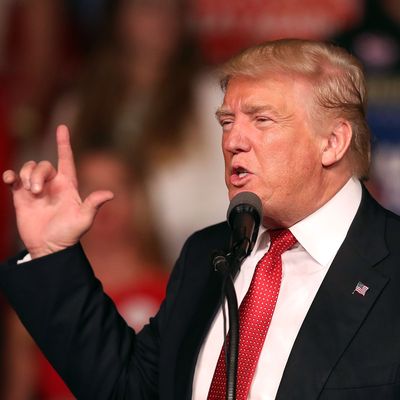
On Wednesday, Donald Trump participated in a town-hall discussion on the issues facing the African-American community. Like most of the birther king’s pantomimes of black outreach, this one was unconvincing from the start: What kind of forum on the state of black America is hosted by Sean Hannity — and attended almost exclusively by white people?
Answer: the kind that a racist demagogue assembles to assure white, suburban Republicans that it isn’t racist to vote for him.
The town hall was set to air on Wednesday night, but was pushed to Thursday due to the violent protests in Charlotte, North Carolina. Early dispatches from its taping lend credence to such an assessment: Asked what he would do to combat “black-on-black” gun crime, Trump suggested that he would force all police departments to stop-and-frisk young men in African-American neighborhoods.
“I would do stop-and-frisk. I think you have to. We did it in New York; it worked incredibly well and you have to be proactive and, you know, you really help people sort of change their mind automatically,” Trump said. “You understand, you have to have, in my opinion, I see what’s going on here, I see what’s going on in Chicago, I think stop-and-frisk. In New York City it was so incredible, the way it worked. Now, we had a very good mayor, but New York City was incredible, the way that worked, so I think that could be one step you could do.”
The campaign later clarified that this proposal was meant solely for the city of Chicago, in light of the city’s “skyrocketing violence.”
Regardless, there are a few problems with this proposal. For one, New York City no longer has stop-and-frisk because a state judge ruled the program was “racially discriminatory” and unconstitutional. For another, there’s little evidence that the program was effective.
In a decade of operation, the NYPD stopped roughly five million New Yorkers, the vast majority of whom were African-American and Latino. Approximately 10 percent of those stopped were arrested or ticketed. In many of these cases, the stops turned up evidence of victimless crime, and young people had their lives disrupted for the offense of possessing marijuana while living in the wrong neighborhood.
Even if one brackets civil-liberties concerns, and judges the policy solely on its merits as a form of a law enforcement, an obvious downside presents itself: Cops rely on community cooperation to solve serious crimes. When cops relentlessly stop and search members of that community on the basis of their skin color, such cooperation is harder to come by.
Against this cost are the number of illegal firearms the program removes from the street. One study found that the NYPD recovered one illegal gun for every thousand people it stopped between 2004 and 2012.
This dismal ratio was not lost on those most vulnerable to the threat stop-and-frisk aims to combat: A 2013 Quinnipiac poll found 67 percent of black New Yorkers opposing stop-and-frisk.
Since New York suspended the practice, it has seen no marked increase in violent crime. Rather, citywide crime rates remain near historic lows.
Beyond the weak substantive case for Trump’s proposal, there’s the audacity of a candidate who rails against moderate gun-safety reforms as civil-liberties violations — but suggests that racially discriminatory police searches are an acceptable means of promoting public safety.
Donald Trump does not care about reducing violent crime in inner-city Chicago. He cares about reducing his unfavorable numbers in the suburbs of Philadelphia: While black New Yorkers opposed stop-and-frisk in 2013, 60 percent of white ones thought the tactic sounded pretty great.






























